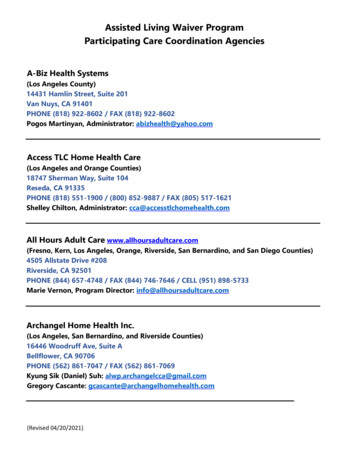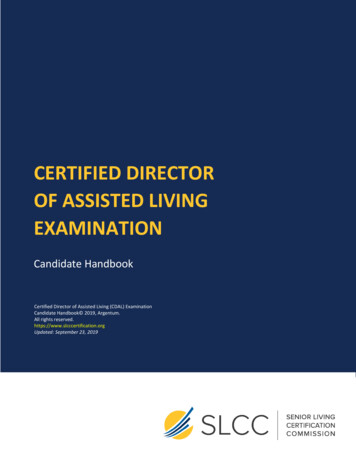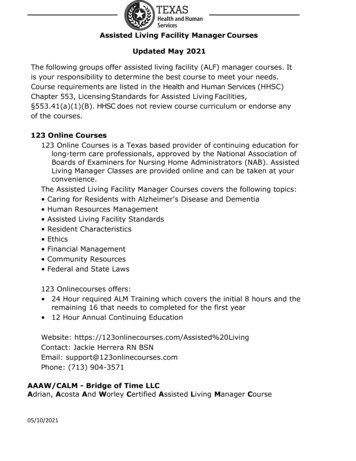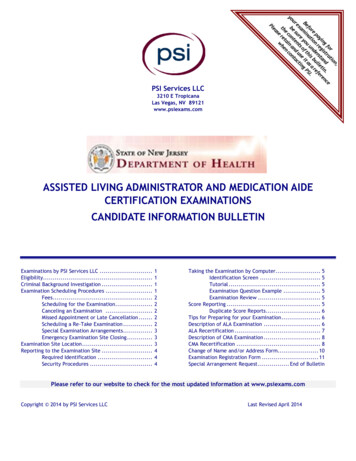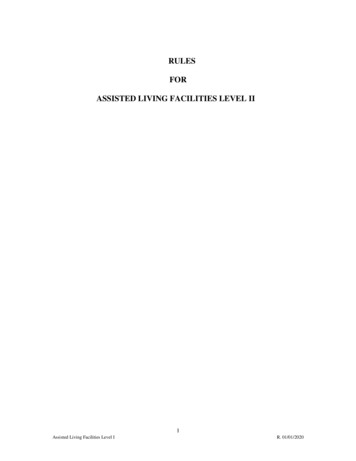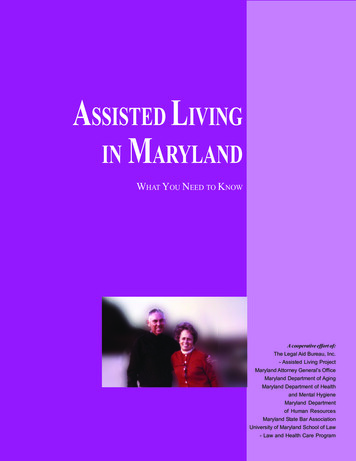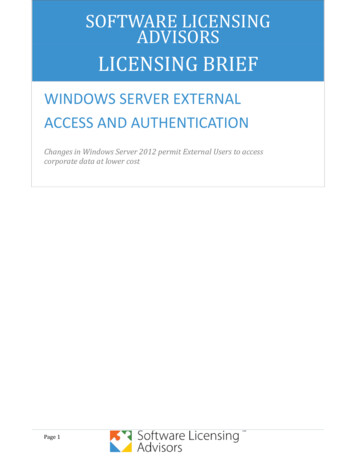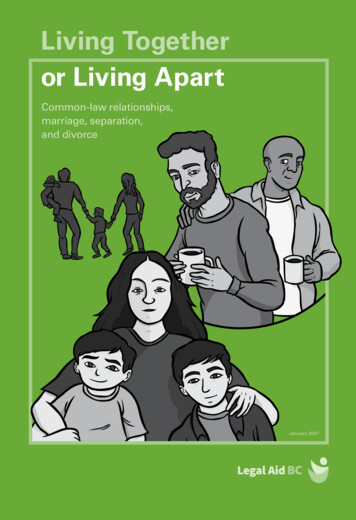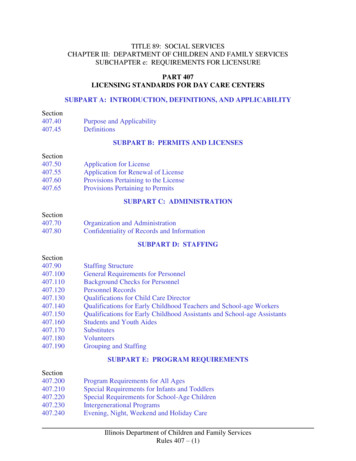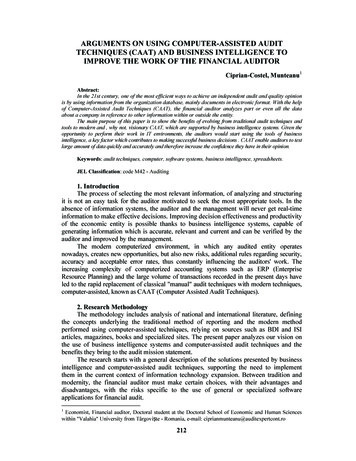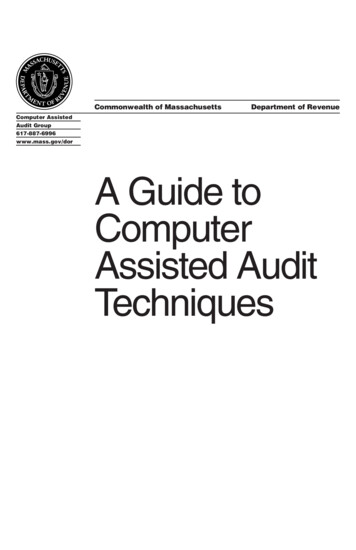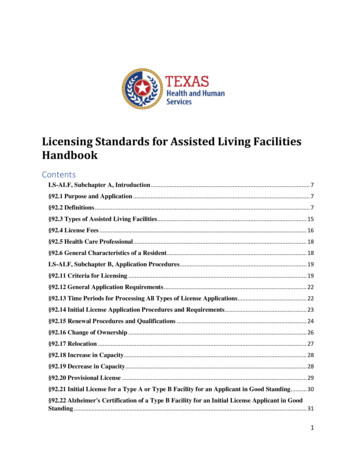
Transcription
Handbooks Licensing Standards for Assisted Living Facilities HandbookLicensing Standards for Assisted Living FacilitiesHandbookContentsLS-ALF, Subchapter A, Introduction . 7§92.1 Purpose and Application . 7§92.2 Definitions . 7§92.3 Types of Assisted Living Facilities . 15§92.4 License Fees . 16§92.5 Health Care Professional . 18§92.6 General Characteristics of a Resident . 18LS-ALF, Subchapter B, Application Procedures . 19§92.11 Criteria for Licensing . 19§92.12 General Application Requirements . 22§92.13 Time Periods for Processing All Types of License Applications. 22§92.14 Initial License Application Procedures and Requirements . 23§92.15 Renewal Procedures and Qualifications . 24§92.16 Change of Ownership . 26§92.17 Relocation . 27§92.18 Increase in Capacity. 28§92.19 Decrease in Capacity. 28§92.20 Provisional License . 29§92.21 Initial License for a Type A or Type B Facility for an Applicant in Good Standing . 30§92.22 Alzheimer's Certification of a Type B Facility for an Initial License Applicant in GoodStanding . 311
LS-ALF, Subchapter C, Standards for Licensure . 34§92.41 Standards for Type A and Type B Assisted Living Facilities . 34§92.42 Guardianship Record Requirements . 58§92.51 Certification of a Facility or Unit for Persons with Alzheimer's Disease and RelatedDisorders . 58§92.53 Standards for Certified Alzheimer's Assisted Living Facilities . 60§92.54 Advertisements, Solicitations, and Promotional Material. 65LS-ALF, Subchapter D, Facility Construction . 66§92.61 Introduction and Application . 66§92.62 General Requirements . 68§92.63 Construction and Initial Survey of Completed Construction . 82§92.64 Plans, Approvals, and Construction Procedures . 86LS-ALF, Subchapter E, Inspections, Surveys, and Visits . 90§92.81 Inspections and Surveys . 90§92.82 Determinations and Actions . 91§92.83 Informal Dispute Resolution . 92Subchapter F, Abuse, Neglect and Exploitations; Complaint and Incident Reports andInvestigations . 93§92.102 Abuse, Neglect, or Exploitation Reportable to DADS . 93§92.103 Complaint Investigation . 94§92.105 Investigations of Complaints . 94§92.106 General Provisions . 95LS-ALF, Subchapter G, Miscellaneous Provisions . 95§92.123 Investigation of Facility Employees . 96§92.124 Procedures for Inspection of Public Records . 96§92.125 Resident's Bill of Rights and Provider Bill of Rights . 98§92.126 Publication of Rules . 102§92.127 Required Postings . 103§92.128 Wheelchair Self-Release Seat Belts . 103§92.129 Authorized Electronic Monitoring (AEM) . 104LS-ALF, Subchapter H, Enforcement . 108Division 1, General Information . 108§92.151 When may DHS take an enforcement action? . 108§92.152 What enforcement actions may DHS take? . 1082
Division 2, Actions Against a License: Suspension . 109§92.201 When may DHS suspend a facility's license? . 109§92.202 Does DHS provide notice of a license suspension and the opportunity for a hearing tothe applicant, license holder, or a controlling person? . 109§92.203 May DHS suspend a license at the same time another enforcement action is occurring?. 109§92.204 How does DHS notify a license holder of a proposed suspension? . 109§92.205 What information does DHS provide the license holder concerning a proposedsuspension? . 109§92.206 Does the license holder have an opportunity to show compliance with all requirementsfor keeping the license before DHS begins proceedings to suspend a license? . 110§92.207 How does a license holder request an opportunity to show compliance? . 110§92.208 How much time does a license holder have to request an opportunity to showcompliance? . 110§92.209 What must the request for an opportunity to show compliance contain? . 110§92.210 How does DHS conduct the opportunity to show compliance? . 110§92.211 Does DHS give the license holder a written affirmation or reversal of the proposedaction? . 110§92.212 How does DHS notify a license holder of its final decision to suspend a license? . 111§92.213 May the facility request a formal hearing?. 111§92.214 How long does a license holder have to request a formal hearing? . 111§92.215 If a license holder does not appeal, when does the suspension take effect? . 111§92.216 If a license holder appeals, when does the suspension take effect?. 111§92.217 May a facility operate during a suspension? . 111§92.218 How long is the suspension? . 111§92.219 How does DHS decide to remove the suspension? . 112§92.220 Must the license be returned to DHS during a license suspension? . 112Division 3, Actions Against a License: Revocation . 112§92.251 When may DHS revoke a license? . 112§92.252 Does DHS provide notice of a license revocation and opportunity for a hearing to theapplicant, license holder, or controlling person? . 113§92.253 May DHS take more than one enforcement action at a time against a license? . 113§92.254 How will DHS notify a license holder of a proposed revocation? . 113§92.255 What information does DHS provide the license holder concerning a proposedrevocation?. 1133
§92.256 Does the license holder have an opportunity to show compliance with all requirementsfor keeping the license before DHS begins proceedings to revoke a license? . 113§92.257 How does a license holder request an opportunity to show compliance? . 113§92.258 How much time does a license holder have to request an opportunity to showcompliance? . 114§92.259 What must the request for the opportunity to show compliance contain? . 114§92.260 How does DHS conduct the opportunity to show compliance? . 114§92.261 Does DHS give the license holder a written affirmation or reversal of the proposedaction? . 114§92.262 Does the license holder have an opportunity for a formal hearing? . 114§92.263 How long does a license holder have to request a formal hearing? . 114§92.264 When does the revocation take effect if the license holder does not appeal?. 115§92.265 When does the revocation take effect if the license holder appeals the revocation? . 115§92.266 May a facility operate during a revocation? . 115§92.267 What happens to a license if it is revoked? . 115Division 4, Actions Against a License: Temporary Restraining Orders and Injunctions . 115§92.301 Why would DHS refer a facility to the Office of the Attorney General or localprosecuting authority for a temporary restraining order or an injunction?. 115§92.302 To whom does DHS refer a facility that is operating without a license? . 116Division 5, Actions Against a License: Emergency License Suspension and Closing Order . 116§92.351 When may DHS suspend a license or order an immediate closing of all or part of afacility? . 116§92.352 How does DHS notify a facility of a license suspension or immediate closing of all orpart of a facility? . 116§92.353 When does an order suspending a license or closing all or part of a facility go intoeffect? . 116§92.354 How long is an order suspending a license or closing all or part of a facility valid? . 117§92.355 May a license holder request a hearing? . 117§92.356 Where can a license holder find information about administrative changes? . 117§92.357 Does a request for an administrative hearing suspend the effectiveness of the order?. 117§92.358 Does anything happen to a resident's rights or freedom of choice during an emergencyrelocation? . 117§92.359 Who does DHS notify if all or part of a facility is closed? . 117§92.360 Who must a facility notify if all or part of the facility is closed? . 118§92.361 Who decides where to relocate a resident? . 1184
§92.362 Who arranges the relocation? . 118§92.363 Is a resident's preference considered?. 118§92.364 What requirements must the facility a resident chooses for relocation meet? . 118§92.365 Is a receiving facility allowed to temporarily exceed its licensed capacity?. 119§92.366 Under what conditions is a receiving facility allowed to temporarily exceed its licensedcapacity? . 119§92.367 What requirements must a facility meet to obtain a temporary waiver? . 119§92.368 How long can a facility have a temporary waiver? . 119§92.369 Does DHS monitor a facility with a temporary waiver?. 119§92.370 What records, reports, and supplies are sent to the receiving facility for transferredresidents? . 119§92.371 May a resident return to the closed facility if it reopens within 90 calendar days?. 120§92.372 Do the relocated residents have any special admission rights at the closed facility? . 120§92.373 What options does a relocated resident have? . 121§92.374 Are relocated residents who return to the facility considered new admissions? . 121Division 6, Actions Against a License: Civil Penalties . 121§92.401 When may DHS refer a facility to the Office of the Attorney General for assessment ofcivil penalties? . 121§92.402 What is the amount of the civil penalty that can be assessed for operating without alicense? . 121Division 7, Trustees: Involuntary Appointment of a Trustee . 121§92.451 When may DHS petition a court for the involuntary appointment of a trustee tooperate a facility? . 122§92.452 When may DHS disburse emergency assistance funds? . 122§92.453 Must a facility reimburse DHS for emergency assistance funds? . 122§92.454 When is reimbursement for emergency assistance funds due to DHS? . 122§92.455 Who is responsible for reimbursement? . 122§92.456 What happens if a facility does not reimburse DHS in one year? . 123Division 8, Trustees: Appointment of a Trustee by Agreement. 123§92.501 May a facility request the appointment of a trustee to assume operation of a facility?. 123§92.502 Who may make the request? . 123§92.503 What are the requirements for a trustee agreement?. 123§92.504 When does an agreement for a trustee terminate? . 1235
§92.505 What happens if the controlling person wants to terminate the agreement, but DHSdetermines termination of the agreement is not in the best interest of the residents?. 124§92.506 When DHS appoints a trustee, is the facility always required to pay assessed civilmoney penalties? . 124Division 9, Administrative Penalties. 124§92.551 Administrative Penalties. 124Division 10, Arbitration . 135§92.601 Arbitration . 135LS-ALF, Subchapter I, Access to Residents and Records by the Long-Term Care OmbudsmanProgram . 135§92.801 Access to Residents and Records by the State Long-Term Care Ombudsman Program. 135LS-ALF, Revisions . 136LS-ALF, 18-2, Revises §92.2, §92.125, §92.127, §92.551 and §92.801 . 137LS-ALF, 18-1, Wheelchair Self Release Seat Belts . 138LS-ALF, 17-2, Updates to Definitions and Change of Ownership . 138LS-ALF, 17-1, ALF Good Standing Alzheimer's Certification and Licensure . 139LS-ALF, Contact Us . 1396
LS-ALF, Subchapter A, IntroductionRevision 18-2§92.1 Purpose and Application(a) The purpose of this chapter is to establish:(1) the criteria and application procedure for licensing an assisted living facility;(2) the licensing standards with which an assisted living facility must comply and that serve as abasis for licensure inspections, including:(A) operation and resident care standards; and(B) facility construction standards;(3) the inspections and investigations DADS may conduct as a regulatory authority; and(4) enforcement actions DADS may take against an assisted living facility.(b) This chapter applies to an assisted living facility licensed or subject to being licensed inaccordance with Texas Health and Safety Code, Chapter 247. Assisted living services are drivenby a philosophy that emphasizes personal dignity and autonomy to age in place in a residentialsetting while receiving increasing or decreasing levels of services as the persons needs change.§92.2 DefinitionsThe following words and terms, when used in this chapter, have the following meaning, unlessthe context clearly indicates otherwise.(1) Abuse —(A) for a person under 18 years of age who is not and has not been married or who has not hadthe disabilities of minority removed for general purposes, the term has the meaning in TexasFamily Code §261.401(1), which is an intentional, knowing, or reckless act or omission by anemployee, volunteer, or other individual working under the auspices of a facility or program thatcauses or may cause emotional harm or physical injury to, or the death of, a child served by thefacility or program as further described by rule or policy; and7
(B) for a person other than one described in subparagraph (A) of this paragraph, the term has themeaning in Texas Health and Safety Code §260A.001(1), which is:(i) the negligent or willful infliction of injury, unreasonable confinement, intimidation, or cruelpunishment with resulting physical or emotional harm or pain to a resident by the resident'scaregiver, family member, or other individual who has an ongoing relationship with the resident;or(ii) sexual abuse of a resident, including any involuntary or nonconsensual sexual conduct thatwould constitute an offense under Section 21.08, Penal Code (indecent exposure), or Chapter 22,Penal Code (assaultive offenses), committed by the resident's caregiver, family member, or otherindividual who has an ongoing relationship with the resident.(2) Accreditation commission — Has the meaning given in Texas Health and Safety Code,§247.032.(3) Advance directive — Has the meaning given in Texas Health and Safety Code, §166.002.(4) Affiliate — With respect to:(A) a partnership, each partner thereof;(B) a corporation, each officer, director, principal stockholder, subsidiary, and each person with adisclosable interest, as the term is defined in this section; and(C) a natural person:(i) said person's spouse;(ii) each partnership and each partner thereof of which said person or any affiliate of said personis a partner; and(iii) each corporation in which said person is an officer, director, principal stockholder, or personwith a disclosable interest.(5) Alzheimer's Assisted Living Disclosure Statement form — The DADS-prescribed form afacility uses to describe the nature of care or treatment of residents with Alzheimer's disease andrelated disorders.(6) Alzheimer's disease and related disorders — Alzheimer's disease and any other irreversibledementia described by the Centers for Disease Control and Prevention (CDC) or the most currentedition of the Diagnostic and Statistical Manual of Mental Disorders.(7) Alzheimer's facility — A type B assisted living facility that is certified to provide specializedservices to residents with Alzheimer's or a related condition.8
(8) Applicant — A person applying for a license to operate an assisted living facility under TexasHealth and Safety Code, Chapter 247.(9) Attendant — A facility employee who provides direct care to residents. This employee mayserve other functions, including cook, janitor, porter, maid, laundry worker, security personnel,bookkeeper, activity director, and manager.(10) Authorized electronic monitoring (AEM) — The placement of an electronic monitoringdevice in a resident's room and using the device to make tapes or recordings after making arequest to the facility to allow electronic monitoring.(11) Behavioral emergency — Has the meaning given in §92.41(p)(2) of this chapter (relating toStandards for Type A and Type B Assisted Living Facilities).(12) Certified Ombudsman — Has the meaning given in 26 TAC §88.2 (relating to Definitions).(13) CFR — Code of Federal Regulations.(14) Change of ownership — An event that results in a change to the federal taxpayeridentification number of the license holder of a facility. The substitution of a personalrepresentative for a deceased license holder is not a change of ownership.(15) Commingles — The laundering of apparel or linens of two or more individuals together.(16) Controlling person — A person with the ability, acting alone or with others, to directly orindirectly influence, direct, or cause the direction of the management, expenditure of money, orpolicies of an assisted living facility or other person. A controlling person includes:(A) a management company, landlord, or other business entity that operates or contracts withothers for the operation of an assisted living facility;(B) any person who is a controlling person of a management company or other business entitythat operates an assisted living facility or that contracts with another person for the operation ofan assisted living facility;(C) an officer or director of a publicly traded corporation that is, or that controls, a facility,management company, or other business entity described in subparagraph (A) of this paragraphbut does not include a shareholder or lender of the publicly traded corporation; and(D) any other individual who, because of a personal, familial, or other relationship with theowner, manager, landlord, tenant, or provider of an assisted living facility, is in a position ofactual control or authority with respect to the facility, without regard to whether the individual isformally named as an owner, manager, director, officer, provider, consultant, contractor, oremployee of the facility, except an employee, lender, secured creditor, landlord, or other personwho does not exercise formal or actual influence or control over the operation of an assistedliving facility.9
(17) Covert electronic monitoring — The placement and use of an electronic monitoring devicethat is not open and obvious, and the facility and DADS have not been informed about the deviceby the resident, by a person who placed the device in the room, or by a person who uses thedevice.(18) DADS — Prior to September 1, 2017, the Department of Aging and Disability Services.September 1, 2017, and after, the Texas Health and Human Services Commission (HHSC).(19) DHS — Formerly, this term referred to the Texas Department of Human Services; it nowrefers to DADS.(20) Dietitian — A person who currently holds a license or provisional license issued by theTexas State Board of Examiners of Dietitians.(21) Direct ownership interest — Ownership of equity in the capital, stock, or profits of, or amembership interest in, an applicant or license holder.(22) Disclosable interest — Five percent or more direct or indirect ownership interest in anapplicant or license holder.(23) Disclosure statement — A DADS form for prospective residents or their legally authorizedrepresentatives that a facility must complete. The form contains information regarding thepreadmission, admission, and discharge process; resident assessment and service plans; staffingpatterns; the physical environment of the facility; resident activities; and facility services.(24) Electronic monitoring device — Video surveillance cameras and audio devices installed in aresident's room, designed to acquire communications or other sounds that occur in the room. Anelectronic, mechanical, or other device used specifically for the nonconsensual interception ofwire or electronic communication is excluded from this definition.(25) Exploitation —(A) for a person under 18 years of age who is not and has not been married or who has not hadthe disabilities of minority removed for general purposes, the term has the mean
Licensing Standards for Assisted Living Facilities Handbook . Licensing Standards for Assisted Living Facilities Handbook Contents LS-ALF, Subchapter A, . §92.125 Resident's Bill of Rights and Provider Bill of Rights .File Size: 669KB
